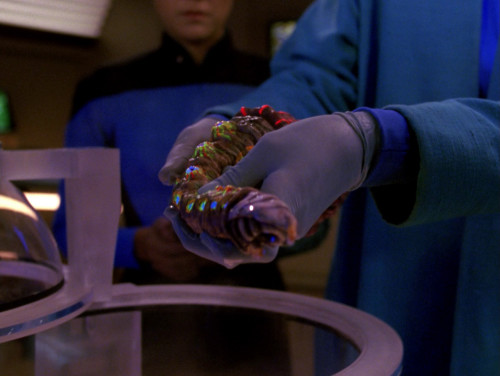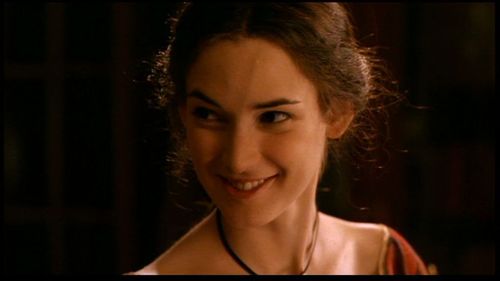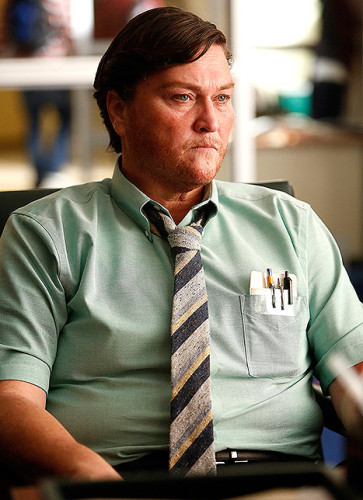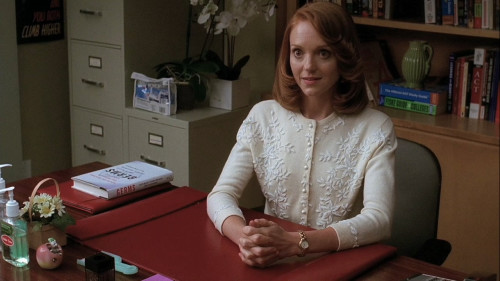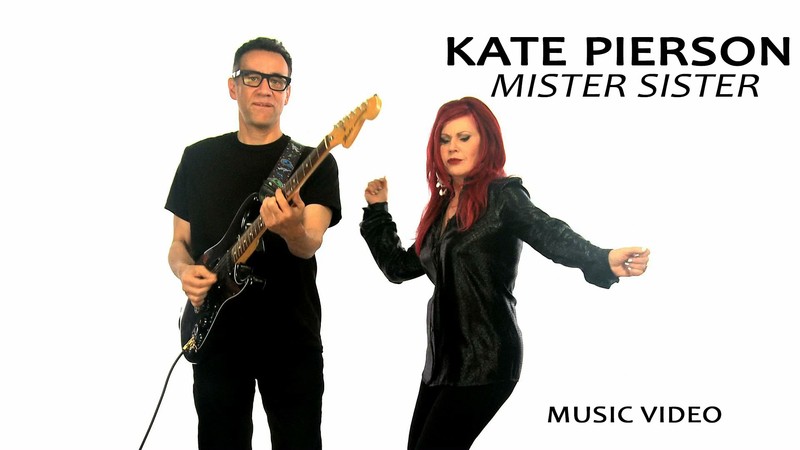This post by Brigit McCone appears as part of our theme week on Depictions of Trans Women.
Priscilla, Queen of the Desert, is a family on wheels. The bright, pink bus that carries three drag queens across the Australian Outback becomes a homely, domestic space, not because of the harmony between the central trio, but because of their acceptance of friction. In their bickering intimacy, the trio model an ideal of accepting surrogate family, all of whose members are allowed to express themselves fully. Bickering and bitchy humour become the symbol of that freedom of self-expression, as much as the trio’s flamboyant, Oscar-winning costumes. There is no toning down to cater to the offended sensibilities of homophobic or transphobic onlookers. Hugo Weaving’s Tic/Mitzi and Terence Stamp’s trans woman Bernadette play the long-suffering parents to Guy Pearce’s abrasive and bratty Adam/Felicia. In the cramped interior of the bus, there is no escape, only a slow journey toward accommodating each other. The fact that there is never a question of romance between the central trio adds to the family vibe of their camaraderie.
The film also openly acknowledges tensions along the transfeminine spectrum. The tension between Felicia and Mitzi’s feminine personas as theatrical performance, and Bernadette’s feminine identity as an integral part of herself, fuels a running feud between Bernadette and Felicia. Bernadette disdains Felicia’s artificiality as “a bloody good little performer, 24 hours a day, seven days a week,” while Felicia torments Bernadette with her “real” name, Ralph, and teases Tic about his marriage to a woman. In their sexuality and gender expression, the group defies easy categorization and perhaps this is the point. To define is to limit. Each of the trio is a work in progress. While tensions between transfemininity as authentic self-realization and as artificial performance simmer between Bernadette and Felicia, Felicia’s own dualities are neatly summed up by Tic: “There are two things I don’t like about you, Felicia: your face.” This conflict is never neatly resolved with an easy moral, but instead accommodated within the broader philosophy of bitchy diversity and tolerated friction that makes the surrogate family work. In the role of Bernadette, meanwhile, Terence Stamp inaugurated the dubious tradition of big name, cismasculine stars playing trans women as a novelty, a demonstration of acting prowess and a marketing gimmick. Stamp’s performance, however, surely ranks among the finest in this genre: restrained, sensitive and toughened at the same time, with an innate dignity and waspish wit that plays well off Bernadette’s more theatrical companions. Casting a cismasculine performer suits the role of Bernadette particularly, since her difficulty in passing as visually female is a part of her character’s ongoing struggle to be recognized for her authentic self.
The contrast between the Paradise of wish fulfillment and infinite self-realization, represented by the flamboyantly decorated bus and the flamboyantly decorated bodies of its occupants, and the harsh desert landscape with its equally harsh standards of small-town conformity and heteronormativity, is the central conflict of the film. Invited to perform for four weeks in Alice Springs, in the middle of the conservative Outback, Tic finds himself returning to face the wife and son he abandoned. Bernadette, by contrast, is fleeing the tragedy of her lover Trumpet’s death. The manner of his death, asphyxiating on his home peroxide, walks the tight-rope between farce and tragedy that the film so excels at. The bittersweet, clashing tone is established by Hugo Weaving’s opening performance, in full drag: “You’re a discontented mother and a regimented wife… I’ve been to Paradise, but I’ve never been to me.” Butch customers play pool and ignore the performance, while Weaving’s drag alter-ego Mitzi gets a can to the back of the head as she walks offstage. Dressed as brightly throughout as birds of paradise, the friction between Paradise and reality is ever present. The trio stifle in the narrow confines of their wheeled refuge, but the outside is a space of danger. As a forfeit in a game of Snap, Mitzi and Felicia wear full multi-colored drag in rural Australia – being hassled in bars by transphobic patrons is a reminder that the element of daring is never far away from unrestrained self-expression. The trio wake to find their bus spray-painted with the slogan “AIDS fuckers go home!” with Tic admitting that “it’s funny you know. No matter how tough I think I’m getting, it still hurts.”
Transfemininity is a protective badge of defiance and toughness, while its wish fulfillment is as hard-earned in a hostile world as Adam’s dream of climbing the hostile terrain of Australia’s King’s Canyon in full drag. As Adam/Felicia is held down and threatened with violence by a transphobic/homophobic crowd, she breaks down in tears and is told by Bernadette to “let it toughen you up.” Her fellow queens have rescued her when she needed it most, showing the caring and solidarity that underpins their bitchy surfaces. The queens will fulfill their dream to conquer King’s Canyon, ceremonially owning the Outback both by this feat of endurance, and by a flamboyant reinterpretation of Outback nature as drag costumes in their Alice Springs performance. The film itself can be read as a similarly flamboyant reimagining of the traditionally macho genre of the road movie, playfully proposing drag as the ultimate journey to self-realization. Breaking down in the desert and practising their drag performance, they are invited to join an Aboriginal Corroboree. Performing a full drag act for the Aborigines, the possibility of an intersectional solidarity between different categories of outsiders and marginalized minorities is suggested, with the didgeridoo accompanying “I will survive.”
The nuclear family is a space of tension and enforced performance for each of the trio. Adam’s abusive uncle tries to swear him to secrecy, while his mother helps him to get the bus Priscilla in the hopes that a trip to the Outback will help him to overcome the “phase” of his gayness and meet a nice country woman. Bernadette is denied the dolls she really wants by parents who insist that she play with traditionally masculine cement mixers, rejecting her and never speaking to her again after she has “the chop.” The traditional family is marked as a hostile space of enforced hypocrisy. Having internalized this vision of nuclear family, Tic cannot reconcile the flamboyance of alter-ego Mitzi with his own narrow ideas about the butch role of husband and father: “Do you think an old queen’s capable of raising a child?” The bus Priscilla’s bitchy diversity serves as a more authentic space of family, because freedom of expression is its watchword. The outside world’s appearance of tradition and conventionality can be deceptive however, covering hidden depths of flexibility and souls who are “starved for entertainment,” like the rural rescuer-mechanic Bob who loves the transfeminine “Le Girls” revue and whose acceptance of unconventional femininity is modelled in his relationship to his Asian “mail-order bride,” Cynthia, as well as his trans-attraction. Cynthia is perhaps the broadest caricature in the film, an exotic dancer who speaks in broken English, and makes “a complete fool of herself” with her compulsive exhibitionism. Bob’s gentlemanly urge to shelter and protect her, however misguided, cannot be separated from his chivalrous urge to protect Bernadette in the pair’s tentatively blossoming romance. The film has no time for respectability politics. Acceptance must be universal, even for the broadest stereotype or most confrontational caricature, otherwise it is worthless. That is the credo of bitchy diversity.
As Tic faints after being watched by his son performing in wild drag as Mitzi, he is told by his bracingly no-nonsense estranged wife that “assumption is the mother of all fuck ups. Don’t bitch to me, bitch to him.” The nuclear family is thus proposed as a potential space of bitchy diversity, where Tic could bitch freely to his son and become a positive role model through the very fact of his freedom. His son accepts his father fully, warmly applauding his drag performance and asking if he has a boyfriend at the moment, while matter-of-factly announcing that his mother used to have a girlfriend. After owning the Outback and reimagining the traditional family, the queens go home, no longer cowering in the city as a defence against the country, but positively choosing it as a homeland of their own, just as Bernadette positively chooses Bob as a home for her heart. The road movie comes to a jubilant all-singing, all-dancing climax to the strains of ABBA’s “Mamma Mia.”
[youtube_sc url=”https://www.youtube.com/watch?v=gAshNAfOHTg”]
See also on Bitch Flicks: “Cinderella II”: The Gender Identity Romcom of Some Like It Hot
Brigit McCone wants to roam the Australian Outback in a dilapidated bus. She writes and directs short films and radio dramas.















